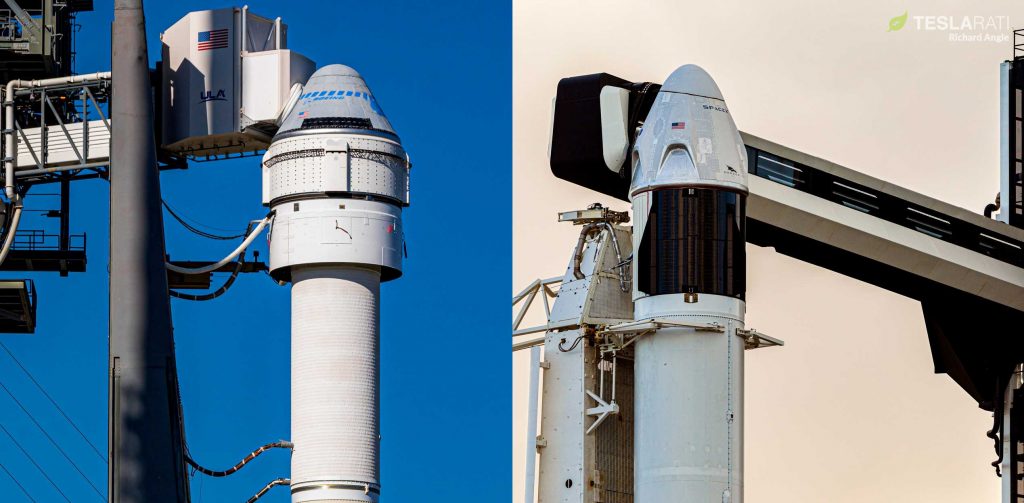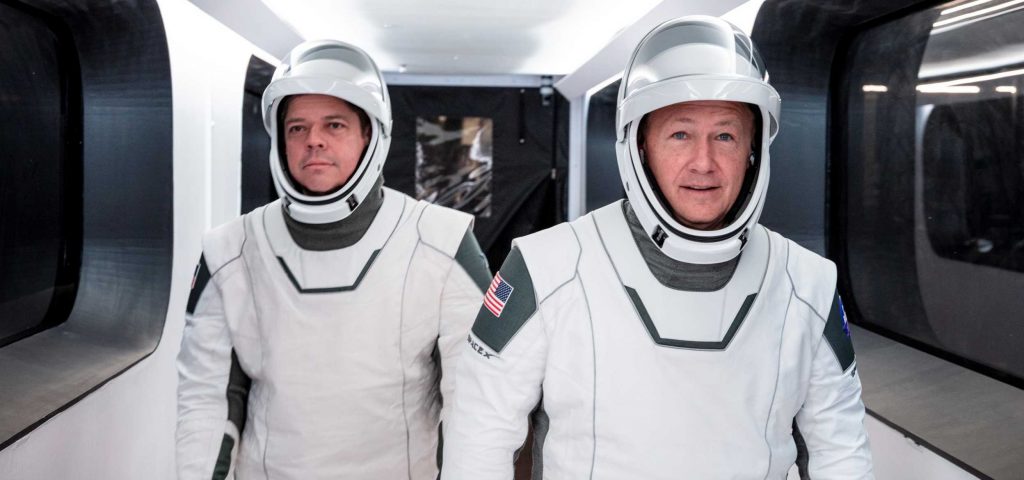NASA has unambiguously confirmed that SpaceX – with its Crew Dragon spacecraft – will soon become the first private company in history to launch astronauts to the International Space Station (ISS), both an unexpected twist from the usually tight-lipped space agency and a major upset for Boeing.
Shortly after revealing that the first astronaut-rated Crew Dragon capsule had been completed and shipped eastward, SpaceX and NASA confirmed that the historic spacecraft arrived at SpaceX’s Florida processing facilities on Thursday, February 13th. With that milestone out of the way, it’s now believed that all the hardware needed for SpaceX’s ‘Demo-2’ astronaut launch debut – Falcon 9 booster B1058, a Falcon 9 upper stage, Crew Dragon capsule C206, and a Crew Dragon trunk – is finished, acceptance-tested, and preparing for flight in Cape Canaveral, Florida.
Extremely out of character for NASA given that Crew Dragon Demo-2 is expected to launch no earlier than two or three months from now, the space agency’s public statement that SpaceX will launch astronauts first simultaneously implies bad news for Boeing and its Starliner spacecraft. Contracted under the Commercial Crew Program in 2014, Boeing – awarded $5.1B – and SpaceX – awarded $3.1B – have been working to build two separate crew launch vehicles (Starliner and Crew Dragon) with the intention of ferrying NASA astronauts to and from the International Space Station (ISS). While both providers have had their own challenges, Boeing has been beset by numerous software failures born out during Starliner’s December 2019 orbital launch debut.

The Commercial Crew account has since deleted its tweet and NASA’s accompanying blog post – linked in said tweet – was tweaked to reflect a slightly different interpretation, but the original text unequivocally stated that “the SpaceX Crew Dragon spacecraft [assigned to] the first crew launch from American soil since 2011 has arrived at the launch site.” Given that both the tweet and blog post contained that exact same phrase, the fact that NASA retroactively censored and corrected itself strongly suggests that SpaceX will, in fact, become the first private company in history to launch astronauts into orbit.
NASA has a fairly notorious and years-long history of going well out of its way to avoid saying or implying anything that could be perceived as even slightly critical of Boeing. A prime contractor dating back to the first stage of the Saturn V rocket, Boeing has effectively secured billions of dollars of NASA’s annual budget and possesses deep political sway thanks in large part to the revolving doors between industry and government and the hundreds of millions of dollars it has spent on lobbying over the last two decades.
More recently, Boeing’s Starliner spacecraft suffered several major software-related failures during its December 2019 Orbital Flight Test, narrowly avoiding a second “catastrophic” failure mode solely because a separate software failure 48 hours prior forced the company to reexamine its code. In simple terms, both software failures probably should and could have been caught and fixed before launch if even a semblance of routine digital simulations and integrated vehicle testing had been performed by Boeing.
Unsurprisingly, NASA – at least after the fact – is now extremely concerned by the lack of such a basic and commonsense level of quality control in Boeing’s Starliner software pipeline. Even NASA, arguably, could and should have been attentive enough to catch some of Boeing’s shortcomings before Starliner’s launch debut. Adding to the embarrassment, NASA performed a “pretty invasive” $5M review of SpaceX’s safety practices and general engineering culture last year, triggered (not a joke) after CEO Elon Musk was seen very briefly smoking on a recorded interview. As part of regulations for the Commercial Crew Program, NASA was obligated to perform a similar review of Boeing’s safety culture, but the contractor demanded that NASA pay five times more – $25M – for the same thing.

NASA unsurprisingly balked at Boeing’s demands and wound up performing a more or less symbolic “paper” review that typically involves ‘auditing’ paperwork supplied by the company itself. Despite the fact that Boeing would soon find itself mired in two fatal 737 Max crashes, killing 346 people as a result of shoddy software, an unreliable design, and bad internal communication, NASA still never pursued a similar safety review with Boeing. Now, only after a nearly-catastrophic in-space failure, NASA has finally decided that that safety review is necessary, while both NASA and Boeing will also have to extensively review all Starliner software and fix the flawed practices used to create and qualify it.
Perhaps most importantly, NASA and Boeing need to determine whether Starliner’s software failures were a one-off fluke or something symptomatic of deeper problems. Due to that uncertainty and the massive amount of work that will be required to answer those questions, it’s almost certain that Boeing will have to perform a second uncrewed Starliner test flight for NASA to verify that its problems have been rectified. A second OFT would almost certainly delay Boeing’s astronaut launch debut by 6-12 months. SpaceX’s astronaut launch debut, for example, was delayed at least 9 months after a Crew Dragon capsule exploded during thruster testing after a flawless orbital launch and recovery.

As a result, even though SpaceX’s Crew Dragon ‘Demo-2’ astronaut launch debut is likely more than two months away, even some part of NASA – famous for incredibly neutral and conservative public statements – appears to be all but certain that SpaceX will launch astronauts first. As of February 13th, 2020, all Demo-2 Falcon 9 and Dragon hardware is likely finished and awaiting integration in Florida. If things go as planned over the next several weeks, Falcon 9 and Crew Dragon could launch astronauts Bob Behnken and Doug Hurley as early as late-April or May 2020.
Check out Teslarati’s newsletters for prompt updates, on-the-ground perspectives, and unique glimpses of SpaceX’s rocket launch and recovery processes.

(adsbygoogle = window.adsbygoogle || []).push({});
<!–
–>
var disqus_shortname = «teslarati»;
var disqus_title = «NASA confirms SpaceX will become the first private company to send astronauts to the space station»;
var disqus_url = «https://www.teslarati.com/nasa-spacex-first-company-orbital-astronaut-launch/»;
var disqus_identifier = «teslarati-130327»;

